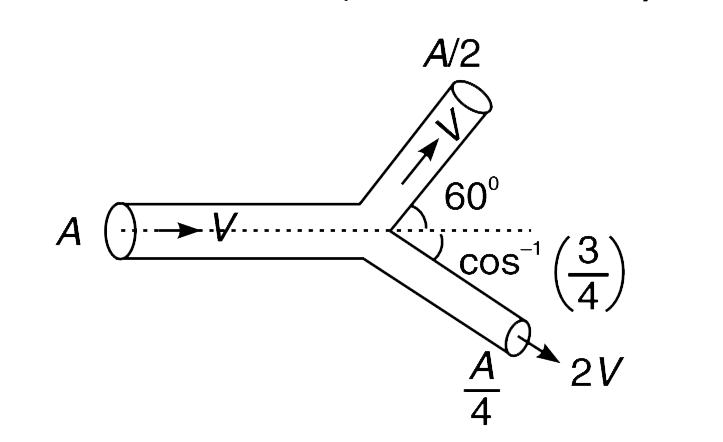Momentum And Center of Mass from ARIHANT PHYSICS Chapter 10 MOMENTUM AND CENTRE OF MASS for Class 11
| Class 11 | PHYSICS |
| Chapter | MOMENTUM AND CENTRE OF MASS |
| ARIHANT PHYSICS | Momentum And Center of Mass |
| Medium | English |
| Academic Year | 2023-2024 |
Question 1
A particle is acted upon by a force for 1 second whose X component remains constant at Fx=30N but y and z components vary with time as shown in the graph. Calculate the magnitude of change in momentum of the particle in 1 s. What angle does the change in momentum (Δ→P) make with X axis ?
 View Solution
View SolutionQuestion 2
Two block A and B of equal mass are connected using a light inextensible string passing over two light smooth pulleys fixed to the blocks (see fig). The horizontal surface is smooth. Every segment of the string (that is not touching the pulley) is horizontal. When a horizontal force F1 is applied to A the magnitude of momentum of the system, comprising of A + B, changes at a rate R. When a horizontal force F2 is applied to B (F1 not applied) the magnitude of momentum of the system A + B once again changes at the rate R. Which force is larger −F1orF2 ?
 View Solution
View SolutionQuestion 3
A particle of mass m=1kg is moving in space in X direction with a velocity of 10ms−1. A 4 N force acting in Y direction is applied on it for a time interval of 5.0s. Later a 5 N force was applied on it in Z direction for 4.0s
(a) Calculate the total work done by both the forces.
(b) Which force performed greater work ? View SolutionQuestion 4
An observer O1 standing on ground finds that momentum of a projectile of mass 2kg changes with time as →P01=(4tˆi+20tˆk)kgm/s Acceleration due to gravity is →g=(10ˆk)m/s2 and there is a wind blowing in horizontal direction. Another observer O2 driving a car observes that momentum of the same projectile changes with time as -
→P02=(8tˆi−16ˆtˆj+20tˆk)kgm/s. Find the acceleration of the car at t=18sView SolutionQuestion 6
A man is running along a road with speed u. On his chest there is a paper of mass m and area S. There is a wind blowing against the man at speed V. Density of air is ρ. Assume that the air molecules after striking the paper come to rest relative to the man. Find the minimum coefficient of friction between the paper and the chest so that the paper does not fall ?View SolutionQuestion 7
Two particles A and B of mass 2 m and m respectively attract each other by mutual gravitational force and no other force acts on them. At time t = 0, A was observed to be at rest and B was moving away from A with a speed u. At a later time t it was observed that B was moving towards A with speed u. Assume no collision has taken place by then. Find work done by the gravitational force in the time interval 0 to t View SolutionQuestion 8
(i) A block of mass m moving towards right with a velocity V strikes (head on) another block of mass M which is at rest connected to a spring. The coefficient of restitution for collision between the blocks is e = 0.5.
Find the ratio Mm for which the subsequent compression in the spring is maximum. There is not friction.

Ball A collides head on with another identical ball B at rest. Find the coefficient of restitution if ball B has 80% of the total kinetic energy of the system after collision. View SolutionQuestion 9
A ball having mass m and velocity u makes a head on collision with another ball. After collision velocity of the ball of mass m was found to be V in the direction of its original motion. The interaction force between the two balls during their collision has been shown in the graph. The area of the shaded part of the graph is same as the area of the not shaded part. Find the velocity of the balls at the instant they were having equal velocity.
 View Solution
View SolutionQuestion 10
Ball A is about to hit a wall at an angle of incidence of θ=30∘. But before hitting the wall it made a head on collision with another identical ball B. The ball B then collides with the wall. The coefficient of restitution for collision between two balls is e1=0.8 and that between a ball and the wall is e1=0.6. Find the final velocity of ball B. Initial velocity of A was u=5ms−1. Neglect friction.
[tan−1(2.252.34)=44∘]
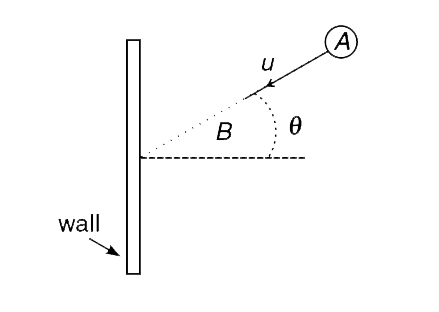 View Solution
View SolutionQuestion 11
Two identical balls A and B are moving as shown in the fig. Ball A hits a smooth floor head on with a velocity u and at the same instant ball B strikes A head on with a horizontal velocity u. The collision between A and B is perfectly inelastic whereas the coefficient of restitution for collision between A and the floor is e=0.5. At what time the two balls will collide again? Assume friction to be absent everywhere.
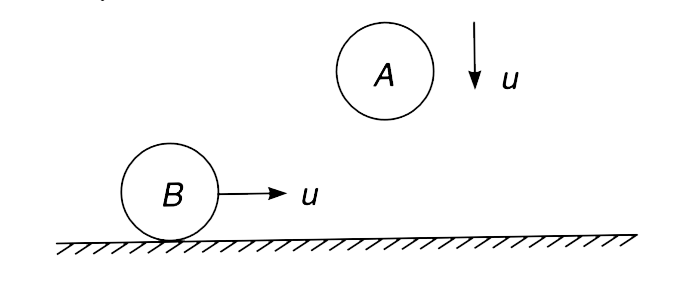 View Solution
View SolutionQuestion 12
Two blocks of mass m and M are lying on a smooth table. A spring is attached with the block of mass M (see fig). Block of mass m is given a velocity towards the other block. Find the value of Mm for which the kinetic energy of the system will never fall below one third of the initial kinetic energy imparted to the block of mass m.
 View Solution
View SolutionQuestion 13
Two identical blocks A and B have two identical springs fixed to them (see fig). Mass of each block is M and force constant of each spring is K. The two blocks have been placed on a smooth table. Another block C of mass m (<<M) is placed between A and B and is held close to A so as to compress the spring attached to A by X0. From this position the system is released. C moves to push B and then is back to push A. The sequence continues until all interactions between the blocks cease. Find the speeds eventually acquired by A and B.
 View Solution
View SolutionQuestion 14
A particle of mass m is flying horizontally at velocity u. It strikes a smooth inclined surface and its velocity becomes vertical.
(a) Find the loss in kinetic energy of the particle due to impact if the inclination of the incline is 60∘ to the horizontal.
(b) Can the particle go vertically up after collision if inclination of the incline is 30∘ ?
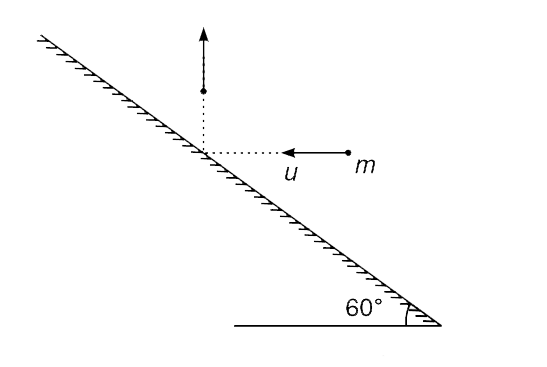 View Solution
View SolutionQuestion 15
A block A of mass 2kg is moving to right with a speed of 5 m/s on a horizontal smooth surface. Another block B of mass 2 kg, with a mass less spring of force constant K=200 N/m attached to it, is moving to left on the same surface with a speed of 3 m/s. Block A collides with the spring attached to B. Calculate
(a) the final velocity of the block A.
(b) the minimum kinetic energy of the system of two blocks during subsequent motion.
(c) Repeat part (b) if there is no spring and the two blocks collide head on. Assume that the blocks are made of perfectly elastic material
 View Solution
View SolutionQuestion 16
A box of mass M is at rest on a horizontal surface. A boy of mass m(<M) wants to push the box by applying a horizontal force on it. The boy knows that he will not be able to push the box as the coefficient of friction μ between his shoes and ground is almost equal to that between the box and the ground. He decides to run, acquire a speed u and then bang into the box. After hitting the box, the boy keeps pushing as hard as possible. What is the maximum distance through which the box can be displaced this way ?
 View Solution
View SolutionQuestion 17
A smooth ball A travels towards another identical ball B with a velocity u. Ball B is at rest and the impact parameter d is equal to √3R where R is radius of each ball. Due to impact the direction of motion of ball A changes by 30∘. Find the velocity of B after the impact. It is given that collision is elastic
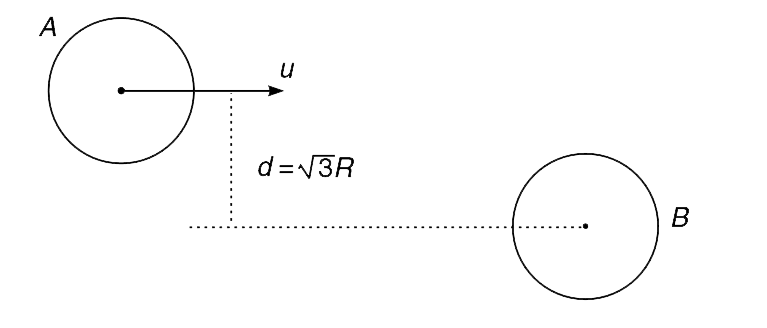 View Solution
View SolutionQuestion 18
(a) Two identical balls are moving along X axis and undergo an elastic collision. Plot the position time graph for the two balls.
(b) Consider five identical balls moving along X axis. What is the maximum number of collisions that is possible? Assume that more than two balls do not collide at the same time and collisions are elastic.View SolutionQuestion 19
Two particles of mass m each are attached to the end of a mass less spring. This dumb-bell is moving towards right on a smooth horizontal surface at speed V with the spring relaxed. Another identical dumb-bell is moving along the same line is opposite direction with the same speed. The two dumb-bells collide head on and collision is elastic. Assuming collisions to be instantaneous, how many collisions will take place ?
 View Solution
View SolutionQuestion 20
Two blocks of mass m1andm2 are moving along a smooth horizontal floor. A non-ideal spring is attached at the back of mass m2. Initial velocities of the blocks are u1andu2 as shown, with u1>u2. After collision the two blocks were found to be moving with velocities V1andV2 respectively. Find the ratio of impulse (on each block) during the deformation phase of the spring and that during its restoration phase. [By non ideal spring we mean that it does not completely regain its original shape after deformation. You can neglect the mass of the spring.]
 View Solution
View SolutionQuestion 21
A ball moving with velocity V0, makes a head on collision with another identical ball at rest. The velocity of incident ball and the other ball after collision is V1 and V2 respectively.
(a) Using momentum conservation write an equation having V1andV2 as unknowns. Plot a graph of V1 vs V2 using this equation.
(b) Assuming the collision to be elastic write an equation for kinetic energy. Plot a graph of V1 vs V2 using this equation.
(c) The intersection point of the above two graphs gives solution. Find V1andV2 .
(d) In a particular collision, the plot of graphs mentioned above is as shown in figure
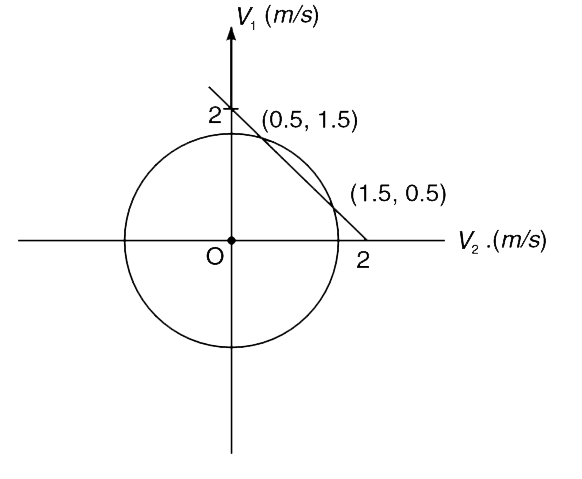
Find V1andV2 for this collision. Also write the percentage loss in kinetic energy during the collision. View SolutionQuestion 22
A particle having charge +q and mass m is approaching (head on) a free particle having mass M and charge 10 q. Initially the mass m is at large distance and has a velocity V0, whereas the other particle is at rest.
(a) Find the final velocity of the two particles when M=20 m.
(b) Find the final state of the two particles if M=m.
 View Solution
View SolutionQuestion 23
In the system shown in fig. block of mass M is placed on a smooth horizontal surface. There is a mass less rigid support attached to the block. Block of mass m is placed on the first block and it is connected to the support with a spring of force constant K. There is no friction between the blocks. A bullet of mass m0, moving with speed u hits the block of mass M and gets embedded into it. The collision is instantaneous. Assuming that m always stays over M, calculate the maximum extension in the spring caused during the subsequent motion.
K=8960N/m,u=400m/s
 View Solution
View SolutionQuestion 24
Starting from a height H, a ball slips without friction, down a plane inclined at an angle of 30∘ to the horizontal (fig.). After leaving the inclined plane it fall under gravity on a parabolic path and hits the horizontal ground surface. The impact is perfectly elastic (It means that there is no change in horizontal component of ball’s velocity and its vertical velocity component gets inverted. There is no change in speed due to collision). Will the ball rise to a height equal to H or less than H after the impact ?
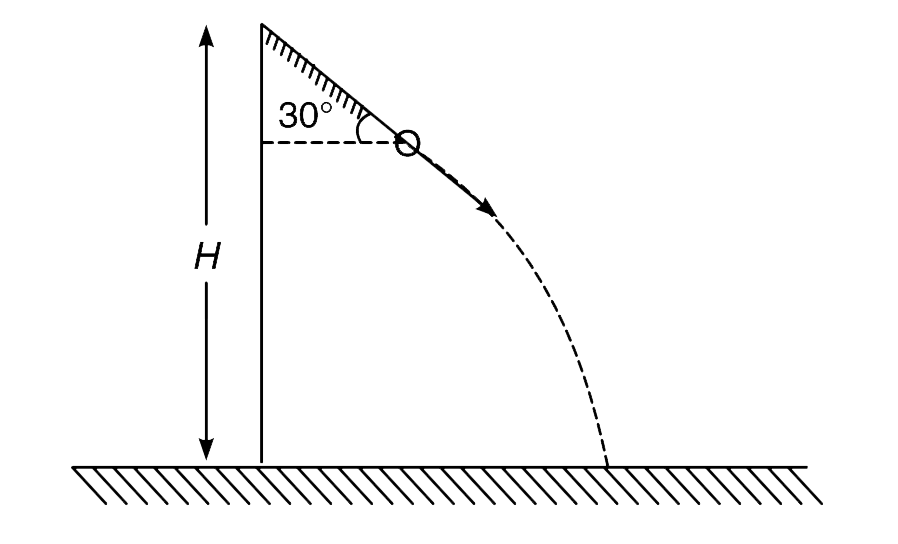 View Solution
View SolutionQuestion 26
A ball of mass m approaches a heavy wall of mass M with speed 4 m/s along the normal to the wall. The speed of wall before collision is 1m/s towards the ball. The ball collides elastically with the wall. What can you say about the speed of the ball after collision? Will it be slightly less than or slightly higher than 6 m/s ? View SolutionQuestion 28
2n identical cubical blocks are kept in a straight line on a horizontal smooth surface. The separation between any two consecutive blocks is same. The odd numbered blocks 1,3,5,.....(2n–1) are given velocity v to the right whereas blocks 2,4,6,......2n are given velocity v to the left. All collisions between blocks are perfectly elastic. Calculate the total number of collisions that will take place.
 View Solution
View SolutionQuestion 29
A small ball with mass M=0.2kg rests on top of a vertical column with height h=5m. A bullet with mass m =0.01kg, moving with velocity v0=500m/s, passes horizontally through the center of the ball. The ball reaches the ground at a horizontal distance s=20m from the column. Where does the bullet reach the ground? What part of the kinetic energy of the bullet was converted into heat when the bullet passed through the ball? Neglect resistance of the air. Assume that g=10m/s2.View SolutionQuestion 30
Figure shows a circular frictionless track of radius R, centred at point O. A particle of mass M is released from point A(OA=R/2). After collision with the track, the particle moves along the track.
(a) Find the coefficient of restitution e.
(b) What will be value of e if the velocity of the particle becomes horizontal just after collision ?
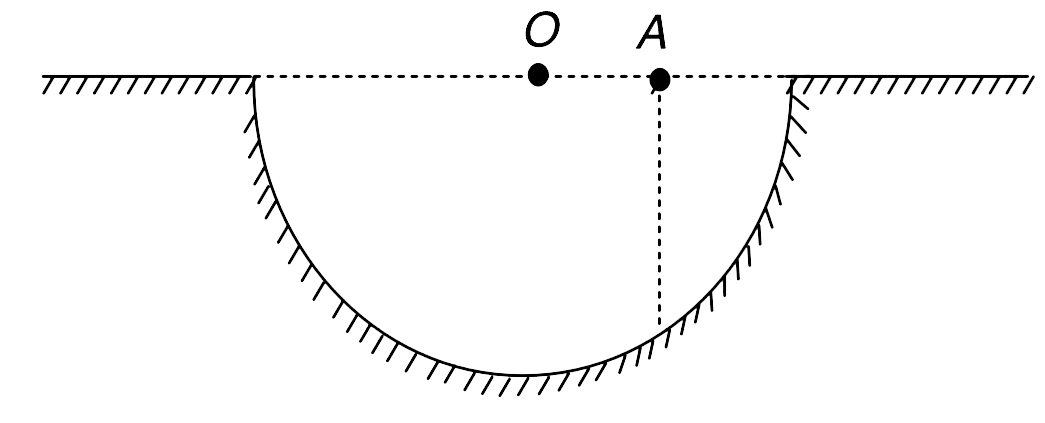 View Solution
View SolutionQuestion 31
A rectangular billiard table has dimensions AB=4√3 feet and BC=2 feet. Ball 1 is at the centre of the table. Ball 2 moving perpendicular to CD hits ball 1. After the collision ball 2 itself goes straight into the hole at. A Prove that ball 1 will fall into the hole at C. Assume that the balls are identical and their dimensions are too small compared to the dimensions of a hole. All collisions are elastic
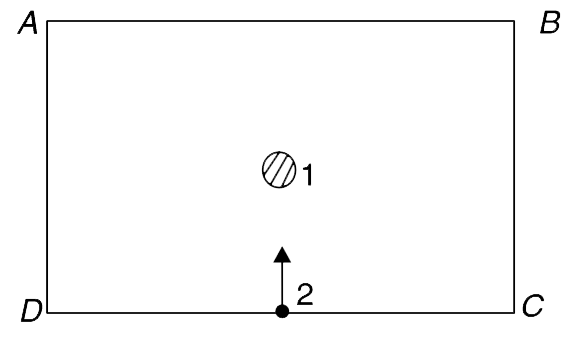 View Solution
View SolutionQuestion 32
Blocks shown in figure have been placed on a smooth horizontal surface and mass of (n+1)th block is 120 times the mass of nth block (where n=1,2,3,4,….). The first block is given an initial velocity u towards the second block. All collision are head on elastic collisions. If u=10m/s then how many blocks must be kept so that the last one acquires speed equal to or greater than the escape speed (=11.0kms−1)
[Take log10(4021)=0.28andlog10(11)=1.04]
 View Solution
View SolutionQuestion 33
There is a long narrow and smooth groove in a horizontal table. Two identical blocks A and B each of mass m are placed inside the groove at some separation. An ideal spring is fixed to A as shown. Block A is given a velocity u to the right and it interacts with B through the spring.

(a) What will be final state of motion of the two blocks ?
(b) During their course of interaction what is the minimum kinetic energy of the system ?
(c) The spring is removed and the two blocks are tied using a mass less string. Now A is set into motion with speed u. What will be the final state of motion of the two blocks in this case ? How much kinetic energy is lost by the system ? Where goes this energy ?
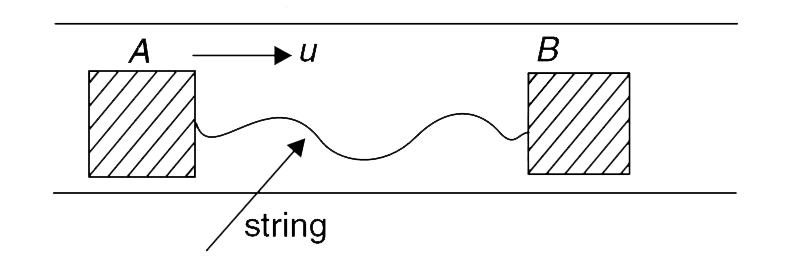 View Solution
View SolutionQuestion 34
A carpet lying on ground has length L, width a and a small thickness d. It is rolled over a light cylindrical pipe of radius r=L100√π and kept on a level ground. Increase in gravitational potential energy of the carpet is ΔU1 (compared to its initial position when it was lying flat). In another experiment the carpet was folded to give it a shape of a cuboid (see figure) having width b. When this is placed on level ground its gravitational potential energy is ΔU2 higher than its initial position (flat on ground). It is given that d=10−4L. Find b for which ΔU1=ΔU2. [Take √π2=1.25]
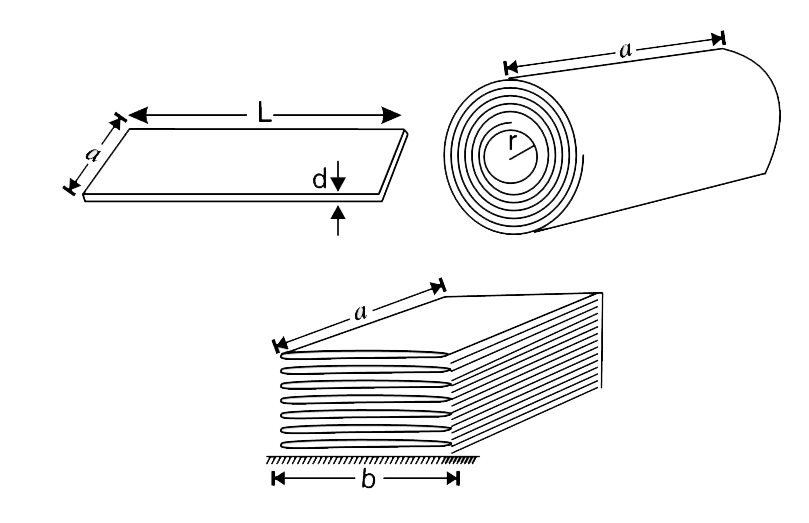 View Solution
View SolutionQuestion 36
(i) A regular polygon has 2016 sides and r is the radius of the circle circumscribing the polygon. Particles of equal mass are placed at 2015 vertices of the polygon. Find the distance of the centre of mass of the particle system from the centre of the polygon.
(ii) In the last problem you have been asked to remove any one particle from the system so that the centre of mass of the remaining 2014 particles lies farthest from the geometrical centre of the polygon. Which particle will you remove ? View SolutionQuestion 37
Two identical block A and B each having mass m, are connected with a spring of force constant k. The floor is smooth and A is pushed so as to compress the spring by x0. The system is released from this position
(a) Calculate the maximum speed of the centre of mass of the system during subsequent motion.
(b) What is acceleration of the centre of mass at the instant it acquires half its maximum speed ?
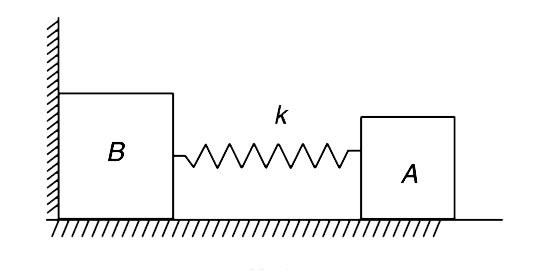 View Solution
View SolutionQuestion 38
A dancer leaps off the floor with her centre of mass having a velocity of 5 m/s making an angle of θ=37∘ to the horizontal. At the top of the trajectory the dancer has her legs stretched so that the centre of mass gets closer to head by a vertical distance of 0.25m. By how much does the head rises vertically from its initial position ? [sin37∘=35]
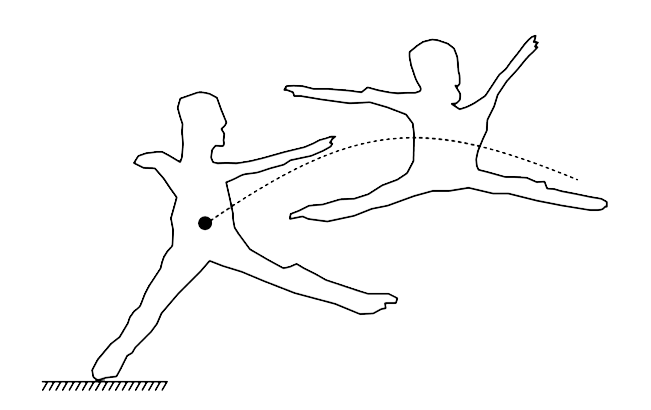 View Solution
View SolutionQuestion 39
In order to make a jump straight up, a 60kg player starts the motion crouched down at rest. He pushes hard against the ground, raising his centre of mass by a height h0=0.5m. Assume that his legs exert a constant force F0 during this motion. At this point, where his centre of mass has gone up by h0 his feet leave the ground and he has an upward velocity of v. Centre of mass of his body rises further by h=0.8m before falling down [Take g=10m/s2]
(a) Find v.
(b) Find the normal force applied by the ground on his feet just before he left the ground. View SolutionQuestion 40
A platform is kept on a rough horizontal surface. At one end A of the platform there is a man standing on it. The man runs towards the end B and the platform is found to be moving. In which direction will the platform be moving after the man abruptly comes to rest on the platform at B ?
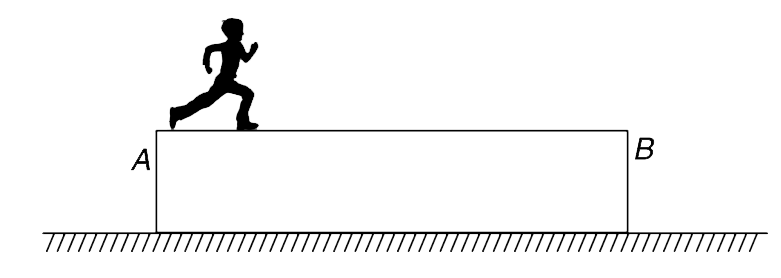 View Solution
View SolutionQuestion 41
Two particles PandQ have mass 1kgand2kg respectively. They are projected along a vertical line with velocity up=20 m/s and uQ=5 m/s when separation between them was 60 m. P was projected vertically up while Q was projected vertically down. Calculate the maximum height attained by the centre of mass of the system of two particles, measured from the initial position of P. Assume that the particles do not collide and that the ground is far below their point of projection [g=10m/s2]
 View Solution
View SolutionQuestion 42
Two small motors are kept on a smooth table at a separation L. The motors have mass Mand2M and are connected by a light thread. The motors begin to wrap the thread and thereby move closer to each other. The tension in the thread is maintained constant at F. Find the time after which the two motors will collide. Neglect the dimensions of the motors and their stands.
 View Solution
View SolutionQuestion 43
Consider a uniform rectangular plate. If a straight line is drawn, passing through its centre of mass (in the plane of the plate), so as to cut the plate in two parts – the two parts obtained are of equal mass irrespective of the orientation of the line. Can you also say that a straight line passing through the centre of mass of a triangular plate, irrespective of its orientation, will also divide the triangle into two pieces of equal mass ? View SolutionQuestion 44
Two spherical bodies of masses m and 5m and radii R and 2R respectively, are released in free space with initial separation between their centres equal to 12 R. If they attract each other due to gravitational force only, the distance covered by smaller sphere just before collision isView SolutionQuestion 45
A shell is fired vertically upward with a speed of 60 m/s. When at its maximum height it explodes into large number of fragments. Assume that the fragments fly in every possible direction and all of them have same initial speed of 25 m/s [Take g=10m/s2]
(a) Prove that after the explosion all the fragments will lie on an expanding sphere. What will be speed of the centre of the sphere thus formed – one second after explosion ?
(b) Find the radius of the above mentioned sphere at the instant the bottom of the sphere touches the ground.View SolutionQuestion 46
A car of mass M is free to move on a frictionless horizontal surface. A gun fires bullets on the car. The bullets leave the stationary gun with speed u and mass rate bkgs−1. The bullets hit the vertical rear surface of the car while travelling horizontally and collisions are elastic. If the car starts at rest find its speed and position as a function of time. Mass of the car M>> mass of each bullet.
 View Solution
View SolutionQuestion 47
(i) Liquid of density ρ flows at speed υ along a flexible pipe bent into a semicircle of radius R. The cross sectional area of the pipe is A and its cross sectional radius is small compared to R. Three strings S1,S2andS3 keep the pipe in place. S3 ties the two ends of the pipe and the other two string have their ends secured at A and B. Strings S1andS2 are perpendicular to the string S3. The entire system is in horizontal plane. Find the tension in the three strings
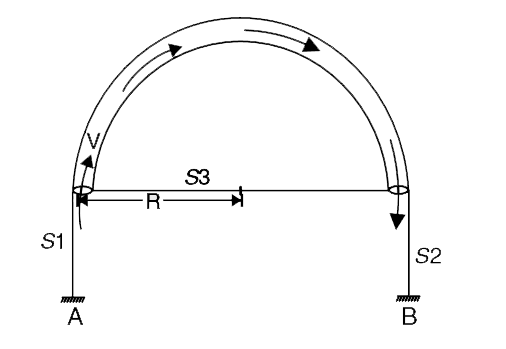
(ii) A car of mass M is moving with a velocity V0 on a smooth horizontal surface. Bullets, each of mass m, are fired horizontally perpendicular to the velocity of the car with a speed u relative to the car. After firing n bullets it was found that the car was travelling with velocity V0 in a direction opposite to its original direction of motion. Assume that mu <<MV0 and also that nm <<M. Find n in terms of other given parameters. View SolutionQuestion 48
A block of mass m=4.4kg lies on a horizontal rough surface. The coefficient of friction between the block and the surface is μ=0.5. A force F starts acting on the block making an angle θ=37∘ to the horizontal. The force changes with time as shown in the graph.
(a) At what time the block begins to move ?
(b) Calculate the maximum speed attained by the block.
[tan37∘=34,g=10ms−2]
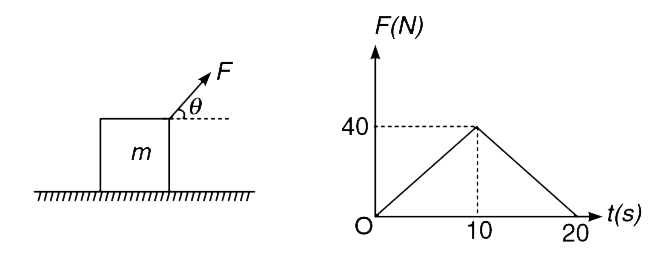 View Solution
View SolutionQuestion 49
A heavy block A is made to move uniformly along a smooth floor with velocity V=0.01 m/s towards left. A ball of mass m=50g is projected towards the block with a velocity of u=100 m/s. The ball keeps bouncing back and forth between the block A and fixed wall B. Each of the collisions is elastic. After the ball has made 1000 collisions with the block and wall each, the distance between the block and the wall was found to be L=1.2m. Calculate the average force being experienced by the block due to collision at this instant. All collision are instantaneous
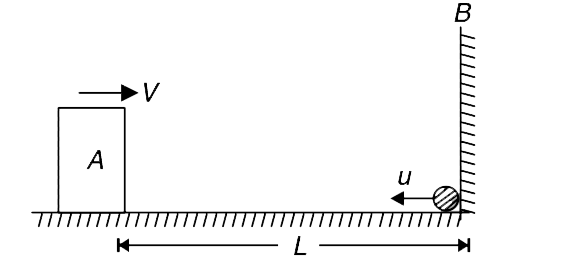 View Solution
View SolutionQuestion 50
A chain (A) of length L is coiled up on the edge of a table. Another identical chain (B) is placed straight on the table as shown. A very small length of both the chains is pushed off the edge and it starts falling under gravity. There is no friction

(a) Find the acceleration of the chain B at the instant L2 length of it is hanging. Assume no kinks in the chain so that the entire chain moves with same speed.
(b) For chain A assume that velocity of each element remains zero until it is jerked into motion with a velocity equal to that of the falling section. Find acceleration of the hanging section at the instant a length l0 has slipped off the table and its speed is known to be v0 at the instant. View SolutionQuestion 51
To understand the effect of air resistance on the motion of a bullet let's consider a bullet of the shape shown in the fig. The bullet is flying horizontally. The cross section of cylindrical part is A and the conical part has a semi vertical angle of 45∘. Assume that the bullet is fired with initial velocity u and moves in a gaseous medium in which molecules are at rest (do you think this assumption is necessary?). Collisions of the molecules with the bullet are elastic. Take mass of bullet to be M, density of gaseous medium as ρ and disregard gravity.
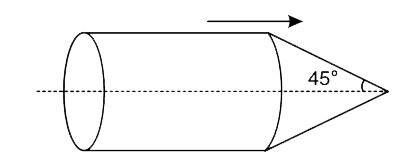
(a) Consider two bullets one small and other large, made of same material. Which will experience larger retardation due to air resistance ?
(b) Write the speed of bullet after time t
(c) Write distance travelled by the bullet in time t. View SolutionQuestion 52
Two particle A and B, of mass 3mand2m respectively, are attached to the ends of a light inextensible string which passes over a smooth fixed pulley of negligible mass. After the system is released and A falls through a distance L, it hits a horizontal inelastic table so that its speed is immediately reduced to zero. Assume that B never hits the table or the pulley. Find
(a) the time for which A is resting on the table after the first collision and before it is jerked off,
(b) the difference between the total kinetic energy of the system immediately before A first hits the table and total kinetic energy immediately after A starts moving upwards for the first time. Explain the loss in kinetic energy.
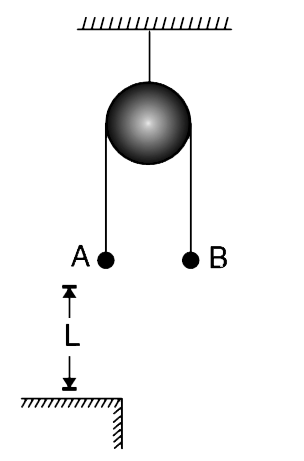 View Solution
View SolutionQuestion 53
A light rod of length L is hinged to a plank of mass m. The plank is lying on the edge of a horizontal table such that the rod can swing freely in the vertical plane without any hindrance from the table. A particle of mass m is attached to the end of the rod and system is released from θ=0∘ position (see figure)
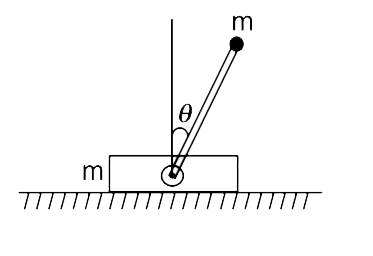
(a) Assume that friction between the plank and the table is large enough to prevent it from slipping and calculate the smallest normal force applied by the plank on the table.
(b) Assume that friction is absent everywhere and calculate the speed of the plank when the rod makes θ=180∘.View SolutionQuestion 54
A block of mass M=5kg is moving on a horizontal table and the coefficient of friction is μ=0.4. A clay ball of mass m=1kg is dropped on the block, hitting it with a vertical velocity of u=10 m/s. At the instant of hit, the block was having a horizontal velocity of v=2 m/s. After an interval of t, another similar clay ball hits the block and the system comes to rest immediately after the hit. Assume that the clay balls stick to the block and collision is momentary. Find t. Take g=10m/s2.
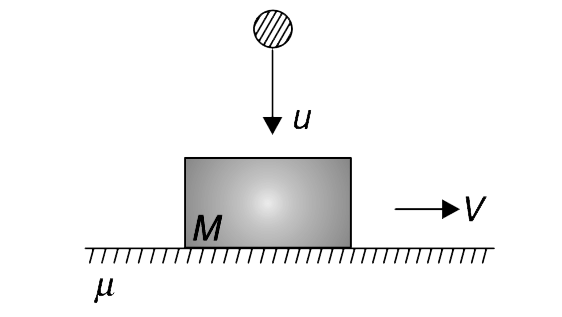 View Solution
View SolutionQuestion 55
Vertical strings of same length L support two balls A and B of mass 2m each. There is a small monkey of mass m sitting on ball A. Suddenly, the monkey jumps off the ball A at an angle θ=45∘ to the horizontal and lands exactly on the ball B. Thereafter, the monkey and the ball B just manage to complete the vertical circle.
(a) Find distance d between the two string and the speed with which the monkey jumped of the ball A.
(b) Find the impulse of the string tension on ball A during the small period when the monkey interacted with the ball to jump off it.
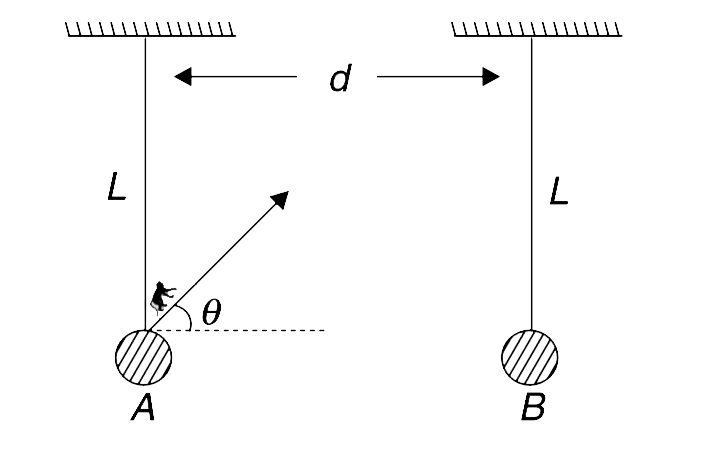 View Solution
View SolutionQuestion 56
In the shown figure, pulleys and strings are ideal and horizontal surface is smooth. The block C (mass 2m) is given a horizontal velocity of V0=3m/s towards right and the entire system is let go. Find the velocity of three blocks, just after the strings regain tension. Mass of A and B are 2mandm respectively and take g=10m/s2.
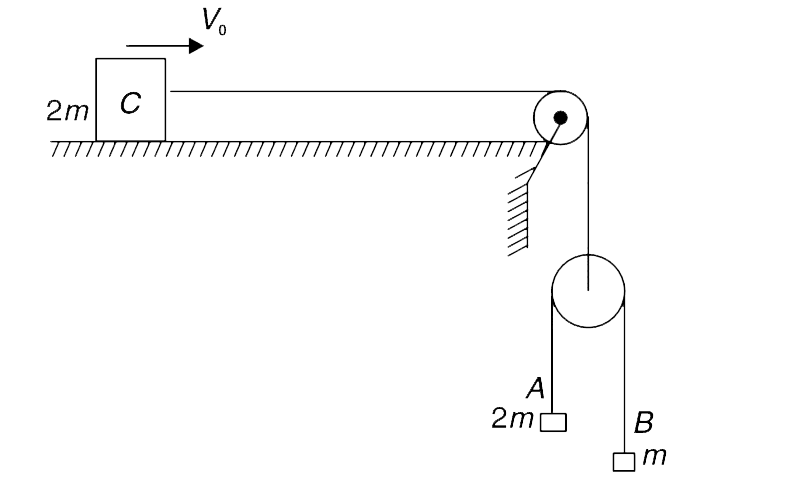 View Solution
View SolutionQuestion 57
Two identical small balls are interconnected with a light and inextensible thread having length L. The system is on a smooth horizontal table with the thread just taut. Each ball is imparted a velocity v, one towards the other ball and the other in a direction that is perpendicular to the velocity given to the first ball.

(a) After how much time the thread will become taut again?
(b) Calculate the kinetic energy of the system after the string gets taut. View SolutionQuestion 58
A particle of mass 1kg is moving with a velocity of 200 m/s. An impulsive force of 4 s duration acts on the particle in a direction opposite to its motion. The force fluctuates a little bit around 40 N magnitude and then it dies out in next 4s showing small fluctuations. An oscilloscope records the force as shown. The two oscillating components in the graph are identical except that one is mirror image of the other. Find the magnitude of velocity of particle after the force stops acting.
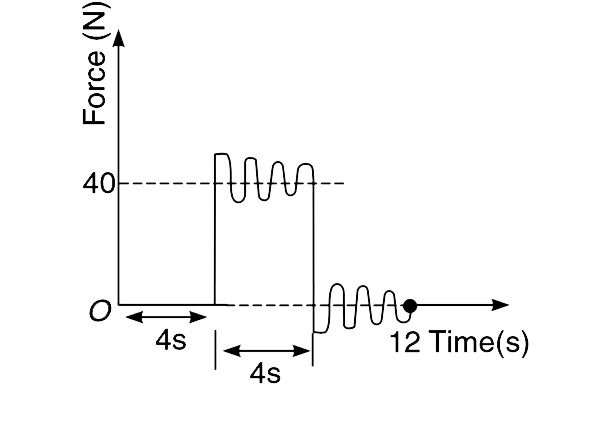 View Solution
View SolutionQuestion 60
Two identical carts are moving on parallel smooth tracks with velocities u1=10ms−1andu2=15ms−1. The empty carts (with drivers) have mass 3m each. Each cart has a sack of mass m kept at end A and end D (see figure). At the instant the carts being to cross, the sack in cart 1 is the thrown perpendicular (relative to cart 1) with some unknown velocity and it lands on cart 2 at its end D after a time t0. Immediately after the sack lands into cart 2, the original sack in cart 2 is thrown perpendicularly (relative to cart 2) towards cart 1 in identical fashion. The sack lands on cart 1 at point M, a time t0 after the throw. Assume that the carts are constrained to move in straight lines.
(i) Find length BM if length of each cart is L
(ii) Find the velocity of cart 1 after the sack thrown from cart 2 lands on it.
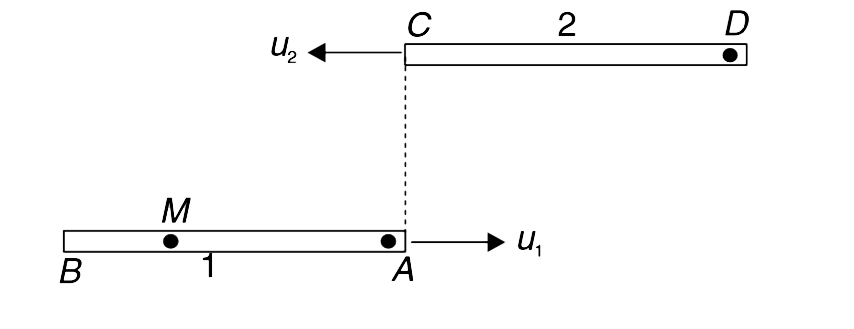 View Solution
View SolutionQuestion 61
A man of mass m is standing on the flat top of a cart of mass 2m. The length and height of the cart is LandH respectively and it is at rest on a smooth horizontal ground. The man starts running from end A, speeds up and jumps out of the cart at point B with a velocity u relative to the cart in horizontal direction. Calculate the total horizontal distance covered by the man by the time he lands on the ground.
 View Solution
View SolutionQuestion 62
Two blocks of masses m=2kgandm=8kg are connected to a spring of force constant K=1kN/m. The spring is compressed by 20cm and the two blocks are held in this position by a string. The system is placed on a horizontal smooth surface and given a velocity u=3m/s perpendicular to the spring. The string snaps while moving. Find the speed of the block of mass m when the spring regains its natural length.
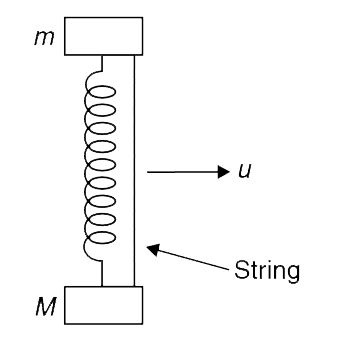 View Solution
View SolutionQuestion 63
Two blocks of mass M and 2M are connected to the two ends of a light, inextensible string passing over an ideal pulley as shown in figure. The system is released from rest.
(a) One second after the system is released, a particle of mass M hits the block of mass M and sticks to it. The particle hits the block with a speed of 10 m/s while travelling downward. Find the total distance travelled by block of mass 2M after it is released.
(b) One second after the system is released, a particle of mass 2M hits the block of mass M and sticks to it. The particle hits the block with a speed of 10 m/s while travelling in upward direction. Find distance travelled by the block of mass 2M after it is released to the time it comes to rest for the first time (g=10m/s)2
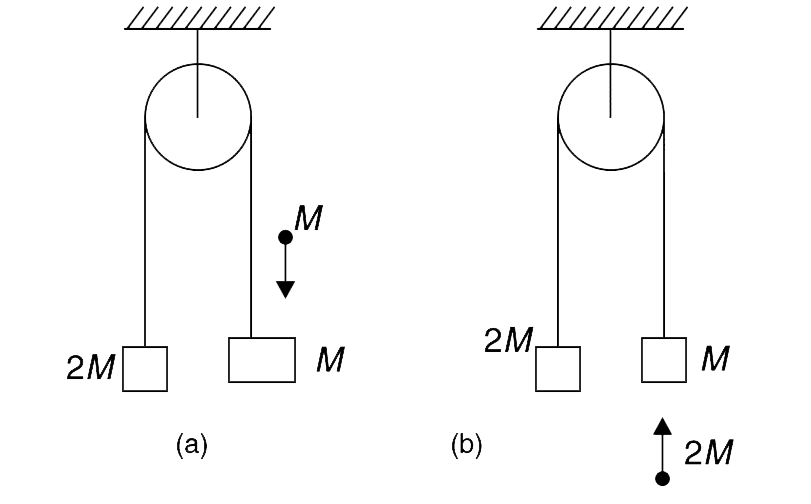 View Solution
View SolutionQuestion 64
A toy car of mass 2m is at rest on a smooth horizontal surface. A small bob of mass m is suspended by a mass less string of length L from the roof of the car. A horizontally flying bullet of mass m enters into the car through a small window and sticks to the bob. Speed of the bullet is u. Find minimum value of u (call it u0) for which the bob can touch the roof of the car
 View Solution
View SolutionQuestion 65
A heap of rope is lying on a horizontal surface. One free end A of the rope is pulled horizontally with a constant velocity v. Assume that the heap does not move and the moving part of the rope remains straight and horizontal (i.e. there is no sag). Mass per unit length of the rope is λ. Find the tension at point P where the straightened part of the rope meets the heap. How much force the external agent must apply at end A ?
 View Solution
View SolutionQuestion 66
A smooth rope of mas m and length L lies in a heap on a smooth horizontal floor, with one end attached to a block of mass M. The block is given a sudden kick and instantaneously acquires a horizontal velocity of magnitude V0 as shown in figure 1. As the block moves to right pulling the rope from heap, the rope being smooth, the heap remains at rest. At the instant block is at a distance x from point P as shown in figure −2(P is a point on the rope which has just started to move at the given instant ), choose correct options for next three question.

The speed of block of mass M is View SolutionQuestion 67
(i) Three balls 1, 2 and 3 lie on a smooth horizontal table. Ball 1 is given a velocity towards ball 2. Kinetic energy given to ball 1 is k0. It collides with 2 and in turn ball 2 hits ball 3. All collisions are head on elastic. Masses of the balls are m, M and m respectively.

(a) Calculate the kinetic energy (k3) of ball 3 after ball 2 hits it.
(b) Draw the variation of k3 as a function of M.
(ii) Consider 10 balls laid on a smooth surface with masses m,m2,m4,m8......m512 and first ball is pushed towards the second with kinetic energy k0. [All collisions are elastic and head on]. The kinetic energy acquired by the last ball is k10. In a separate experiment the 10th ball is pushed towards 9th ball with kinetic energy k0. This time the kinetic energy acquired by 1st ball is k1.
Compare k10andk1
 View Solution
View SolutionQuestion 68
A simple pendulum is suspended from a peg on a wall which is inclined at an angle of 30∘ with the vertical. The pendulum is pulled away from the wall to a horizontal position (with string just taut) and released. The bob repeatedly bounces off the wall, the coefficient of restitution being e=2√5
Find the number of collisions of the bob with the wall, after which the amplitude of oscillation (meaured from the wall) becomes less than 30∘
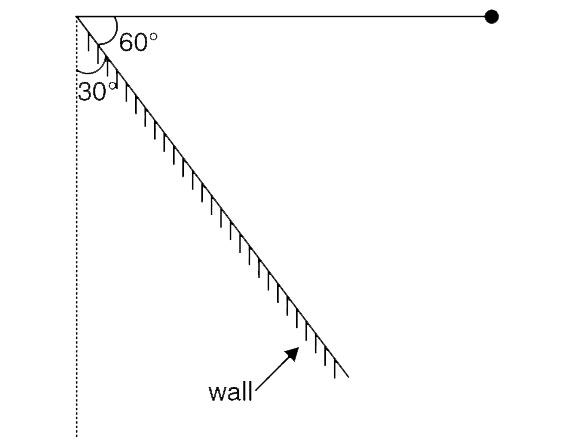 View Solution
View SolutionQuestion 69
Two particles A and B, having same mass m are tied to a common point of suspension O. A is tied with the help of an inextensible string of length L and B is tied using an elastic string of unstretched length L2 . The two particles are released from horizontal positions as shown in figure. The particles have been released at a time gap so that both the string and the elastic cord become vertical simultaneously. It was observed that the length of the cord became equal to that of the string at this moment and the two particles collided. The particles got stuck together and their velocity just after the collision was observed to be √gL2.
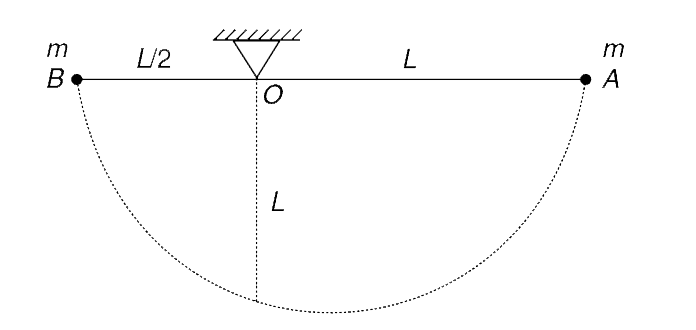
(a) In which direction will the combined mass move immediately after collision – right or left ?
(b) Find tension in the string immediately after the collision. View SolutionQuestion 70
A smooth track, fixed to the ground, is in the shape of a quarter of a circle. Two small blocks of mass 3mand2m are released from the two edges AandB of the circular track. The masses slide down and collide at centre O of the track. Vertical height of A and B from O is h=2m. Collision is elastic. Find the maximum height (above O) attained by the block of mass 2m after collision
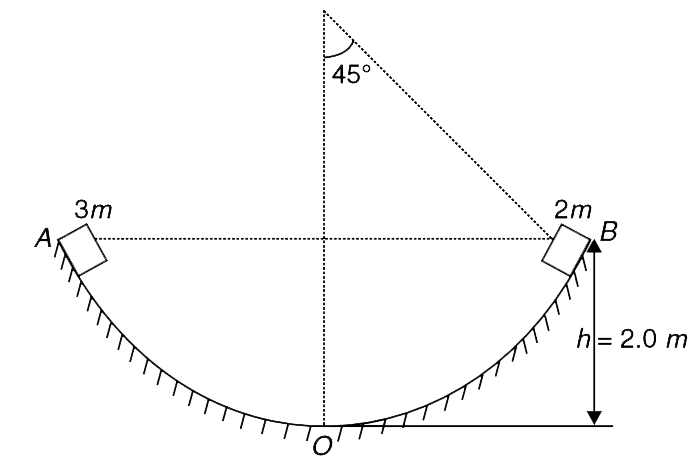 View Solution
View SolutionQuestion 71
A man stands on a frictionless horizontal ground. He slides a 10 kg block on the surface with a speed of 3 m/s relative the ground, towards a vertical massive wall. The wall itself it moving towards the man at a constant speed of 2 m/s. The block makes a perfectly head on elastic collision with the wall, rebounds and reaches back to the man 3 second after the throw. At the moment the block was thrown, the wall was at a distance of 10 m from the man.
(a) Find the mass of the man.
(b) Find the ratio of work done by the man in throwing the block to the work done by the wall on the block. View SolutionQuestion 72
A ball is projected from point A in horizontal direction with a velocity of u=28m/s. It hits the incline plane at point B and rebounds. Show that whatever be the coefficient of restitution between the ball and the incline, the ball will always hit the incline for the second time at a point above B (i.e., it will not hit the incline below B). Assume the incline to be smooth and take g=10m/s2[sin37∘=35]
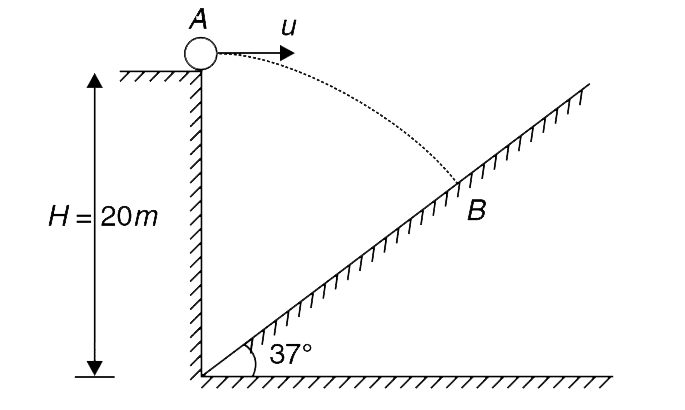 View Solution
View SolutionQuestion 73
A staircase has each step of height h and width x. A ball strikes the centre point of a step with velocity v making an angle θ with the vertical. It rebounds and strikes the centre point of the next step. Once again it rebounds and hits the centre point of the next step and so on.
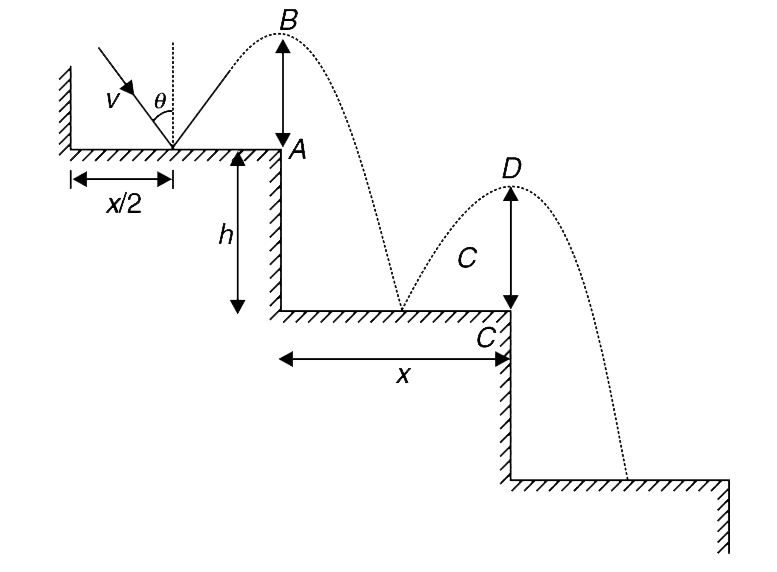
Assume that there is no friction between the ball and the steps and coefficient of restitution is e.
(a) Show that each time after hitting a step, the ball climbs to the same height (i.e., heights like AB and CD shown in figure are equal).
(b) Find h and x.View SolutionQuestion 74
Two identical discs are initially at rest in contact on a horizontal table. A third disc of same mass but of double radius strikes them symmetrically and comes to rest after the impact.
(a) Find the coefficient of restitution for the impact.
(b) Find the minimun kinetic energy of the system (as a percentage of original kinetic energy before collision) during the process of collision.
Treat the collision to be instantaneous
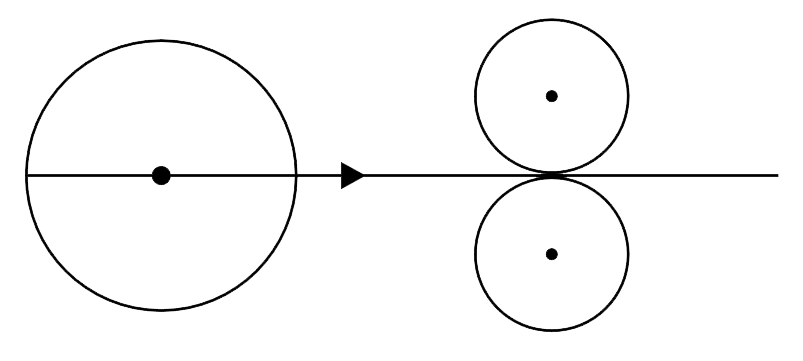 View Solution
View SolutionQuestion 75
On a billiard table two balls B and C are at rest touching each other. A third ball A, travelling with speed u, strikes the two balls elastically (see fig.). Somehow, A hits B first and within a fraction of a second hits ball C. You may assume that B and C are placed symmetrically with respect to the line of motion of A and that all the balls are identical. What angle does the final velocity of A make with its original direction of motion.
 View Solution
View SolutionQuestion 76
A toy car of mass m is placed on a smooth horizontal surface. A particle of mass 3m is suspended inside the car with the help of a string of length l. Initially everything is at rest. A sudden horizontal impulse I=2m√gl is applied on the car and it starts moving.
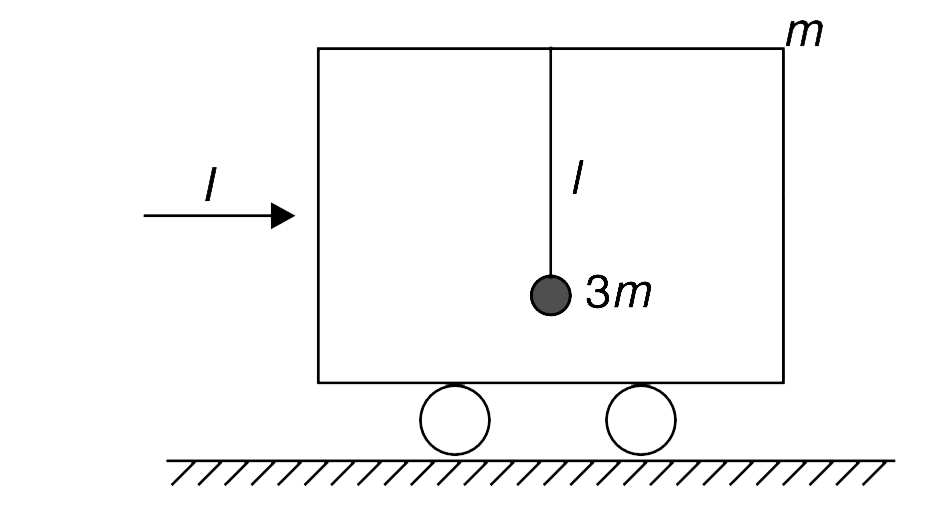
(a) Find the maximum angle q0 that the string will make with the vertical subsequently.
(b) Find tension in the string when it makes angle θ0 with the vertical.View SolutionQuestion 77
A smooth ball of mass M and radius R is lying on a smooth horizontal table. A smaller ball of radius r and mass m travelling horizontally on the table with velocity u hits the larger ball. Collision is elastic. During the interaction of the balls the larger ball does not lose contact with the table at any instant
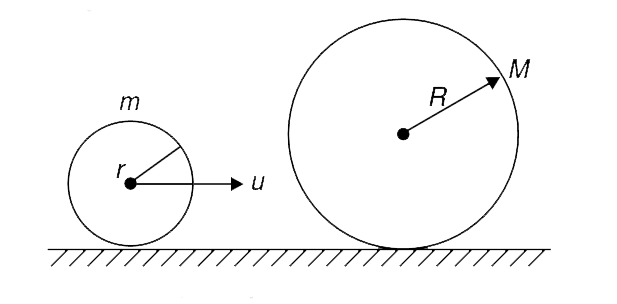
(i) Calculate the velocity of the balls after collision.
(ii) Calculate the maximum possible interaction force between the balls during collision. View SolutionQuestion 78
A light rigid rod has a small ball of mass m attached to its one end. The other end is hinged on a table and the rod can rotate freely in vertical plane. The rod is released from vertical position and while falling the ball at its end strikes a hemisphere of mass m lying freely on the table. The collision between the ball and the hemisphere is elastic. The radius of hemisphere and length of the rod are R and 2R respectively. Find the velocity of the hemisphere after collision.
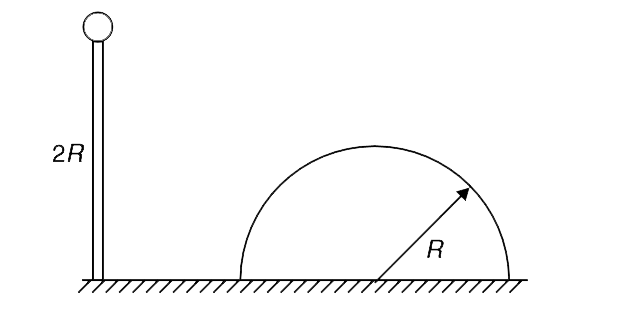 View Solution
View SolutionQuestion 79
(i) O is a fixed peg at a height H above a perfectly inelastic smooth horizontal plane. A light inextensible string of length L(>H) has one end attached to O and the other end is attached to a heavy particle. The particle is held at the level of O with string horizontal and just taut and released from rest. Find the height of the particle above the plane when it comes to rest for the first time after the release.
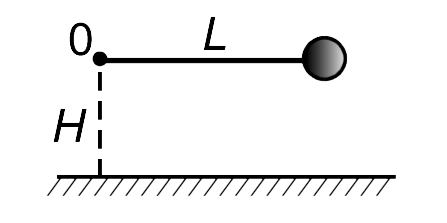
(ii) The bob of a pendulum has mass m and the length of pendulum is l. It is initially at rest with the string vertical and the point of suspension at a height 2l above the floor. A particle P of mass m2 moving horizontally along –ve x-direction with velocity √2gl collides with the bob and comes to rest. The bob swings and when it comes to rest for the first time, another particle Q of mass m moving horizontally along y direction collides with the bob and sticks to it. It is observed that the bob now moves in a horizontal circle.

(a) Find tension in string just before the second collision.
(b) Find the height of the circular path above the floor.
(c) Find the time period of the circular motion.
(d) The string breaks during the circular motion at time t=0. At what time the bob will hit the floor ? View SolutionQuestion 81
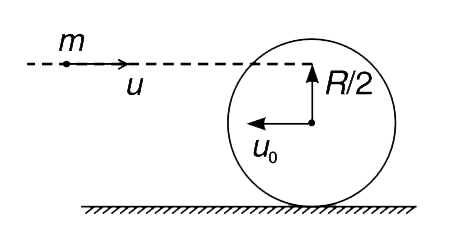
A heavy ball of radius R is travelling on a smooth horizontal surface with a velocity of u0 towards left. A horizontally moving small ball of mass m strikes it at a height R2 above the centre while travelling with velocity u towards right.
(a) After collision the small ball moves in vertically upwards direction with velocity u. Prove that this can happen only if u>√3u0
(b) Find the velocity of small ball after collision if the collision is elastic and the balls are smooth. View SolutionQuestion 82
Two elastic balls of masses M and m (M>>m) are placed on top of each other with a small gap between them. The balls are dropped on to the ground with the bottom of the lower ball at height h above the ground. The lower ball has a radius R and the upper ball has negligible dimension.
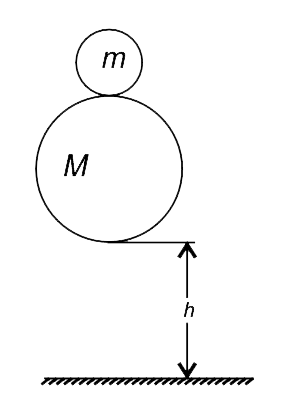
(a) Up to what height the ball of mass m will bounce above the ground ?
(b) Does the result obtained above violates the low of conservation of mechanical energy? View SolutionQuestion 84
A light inextensible string, passing over a pulley, supports two particles 1 and 2 at its ends. An insect of mass m is sitting on particle 2 and the system is in equilibrium. The sum of masses of particles and the insect is M. Now the insect crawls a distance x up relative to the string. Find the displacement of centre of mass of the system of two particles and the insect. In which direction does the centre of mass move and why ?
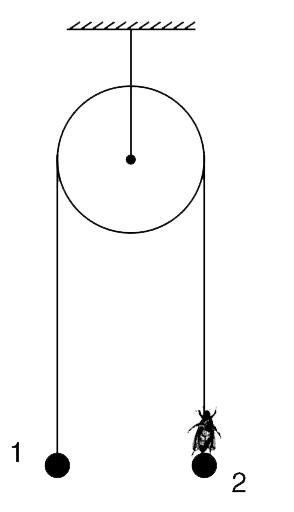 View Solution
View SolutionQuestion 85
Two particles (A and B) of masses m and 2m are joined by a light rigid rod of length L. The system lies on a smooth horizontal table. The particle (A) of mass m is given a sharp impulse so that it acquires a velocity u perpendicular to the rod. Calculate maximum speed of particle B during subsequent motion. By what angle θ will the rod rotate by the time the speed of particle B become maximum for the first time ?
 View Solution
View SolutionQuestion 86
Two blocks A and B, each of mass m, are connected by a spring of force constant K. Initially, the spring is in its natural length. A horizontal constant force F starts acting on block A at time t=0 and at time t , the extension in the spring is seen to be l. What is the displacement of the block A in time t ?
 View Solution
View SolutionQuestion 87
Two blocks of mass m1andm2 are connected to the ends of a spring. The spring is held compressed and the system is placed on a smooth horizontal table. The block of mass m1=2kg is kept at x=1cm mark and the other block is at x=2cm mark. The system is released from this position. It was observed that at the instant m1 was at x=5cm mark its velocity was zero and at that moment m2 was located at x=−4cm. Find mass m2 and unstretched length (l0) of the spring
 View Solution
View SolutionQuestion 88
Two particles having masses m1andm2 are moving with velocities →V1and→V2 respectively. →V0 is velocity of centre of mass of the system.
(a) Prove that the kinetic energy of the system in a reference frame attached to the centre of mass of the system is KEcm=12μV2rel. Where μ=m1m2m1+m2 and Vrel is the relative speed of the two particles.
(b) Prove that the kinetic energy of the system in ground frame is given by
KE=KEcm+12(m1+m2)V20
(c) If the two particles collide head on find the minimum kinetic energy that the system has during collision.View SolutionQuestion 89
Two blocks A and B of mass m and 2m respectively are connected by a light spring of force constant k. They are placed on a smooth horizontal surface. Spring is stretched by a length x and then released. Find the relative velocity of the blocks when the spring comes to its natural length
 View Solution
View SolutionQuestion 90
Two ring of mass m and 2m are connected with a light spring and can slide over two frictionless parallel horizontal rails as shown in figure. Ring of mass m is given velocity 'v0' in horizontal direction as shown. Calculate the maximum stretch in spring during subsequent motion.
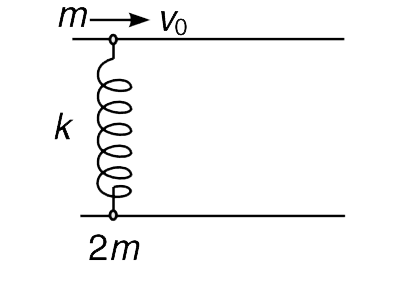 View Solution
View SolutionQuestion 91
A disc of mass M and radius R is kept flat on a smooth horizontal table. An insect of mass m alights on the periphery of the disc and begins to crawl along the edge.
(a) Describe the path of the centre of the disc.
For what value of mM the centre of the disc and the insect will follow the same path ?
 View Solution
View SolutionQuestion 92
A metal wire having mass M is bent in the shape of a semicircle of radius R and is sliding inside a smooth circular grove of radius R present in a horizontal table. The wire just fits into the groove and is moving at a constant speed V. Find the magnitude of net force acting on the wire.
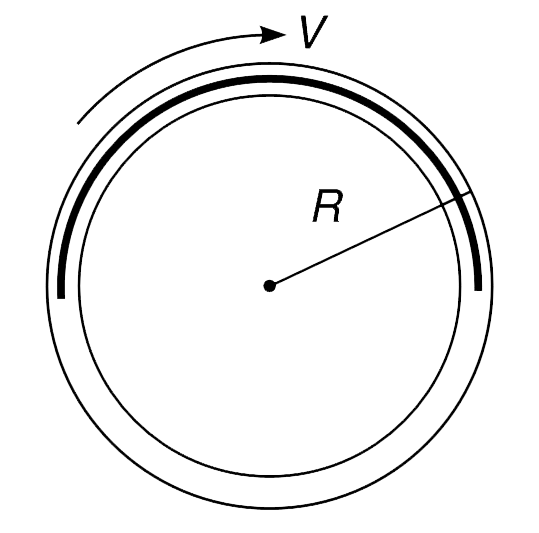 View Solution
View SolutionQuestion 93
A triangular wedge (A) has inclined surface making an angle θ=37∘ to the horizontal. A motor (M) is fixed at the top of the wedge. Mass of the wedge plus motor system is 3m. A small block (B) of mass m=1kg is placed at the bottom of the incline and is connected to the motor using a light string. The motor is switched on and it slowly hauls block B through a distance L=2.0 meter along the incline. Calculate the work done by the string tension force on the wedge plus motor system. All surfaces are frictionless.
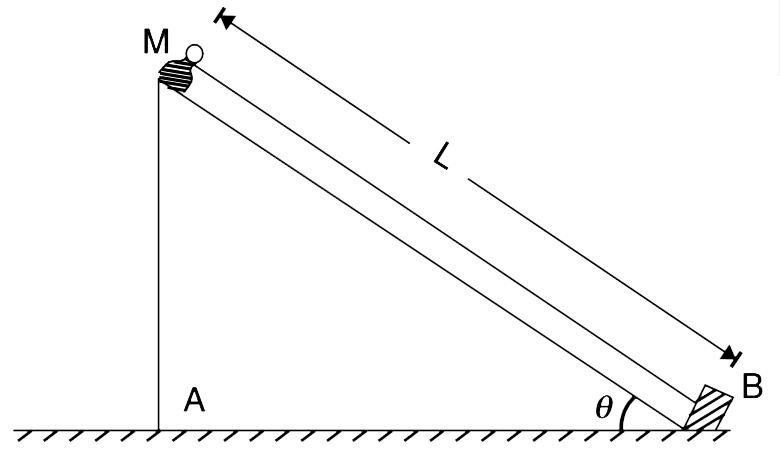 View Solution
View SolutionQuestion 94
An ice cream cone of mass M has base radius R and height h. Assume its wall to be thin and uniform. When ice cream is filled inside it (so as to occupy the complete conical space) its mass becomes 5M. Find the distance of the centre of mass of the ice cream filled cone from its vertex. View SolutionQuestion 95
A flexible rope is in the shape of a semicircle ACB with its centre at O. Ends A and B are fixed. Radius of the semicircle is R. The midpoint C is pulled so that the rope acquires V shape as shown in the figure.
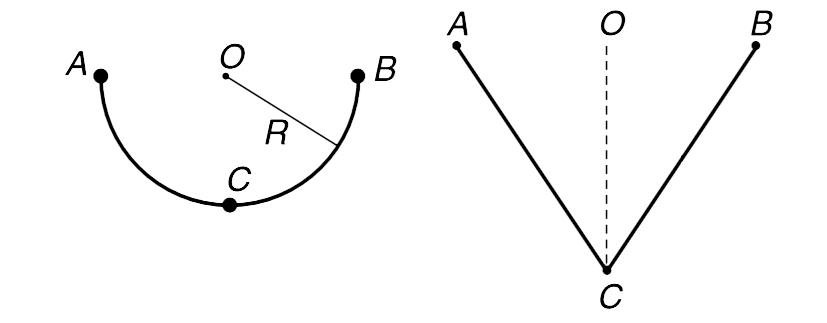
(a) Make a guess whether the centre of mass of the rope moves closer to O or moves away from it when it is pulled?
(b) Calculate the shift in position of the centre of mass of the rope. View SolutionQuestion 96
Three small balls of equal mass (m) are suspended from a thread and two springs of same force constant (K) such that the distances between the first and the second ball and the second third ball are the same. Thus the centre of mass of the whole system coincides with the second ball. The thread supporting the upper ball is cut and system starts a free fall. Find the distance of the centre of mass of the system from the second ball when both the springs acquire their natural length in the falling system.
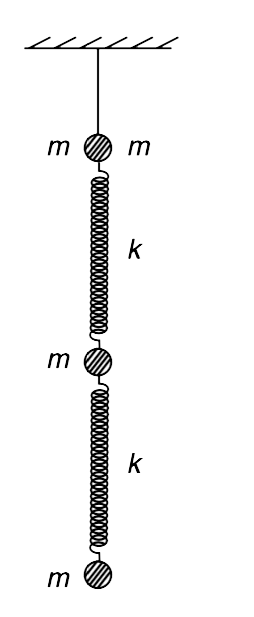 View Solution
View SolutionQuestion 97
(a) A uniform chain is lying in form of on arc of a circle of radius R. The arc subtends an angle of 2α at the centre of the circle. Find the distance of the centre of mass of the chain from the centre of the circle.
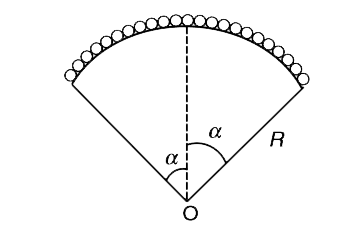
(b) A uniform chain of length πR2 is lying symmetrically on the top of a fixed smooth half cylinder (see figure) of radius R. The chain is pulled slightly from one side and released. It begins to slide. Find the speed of the chain when its one end just touches the floor. What is speed of centre of mass of the chain at this instant ?
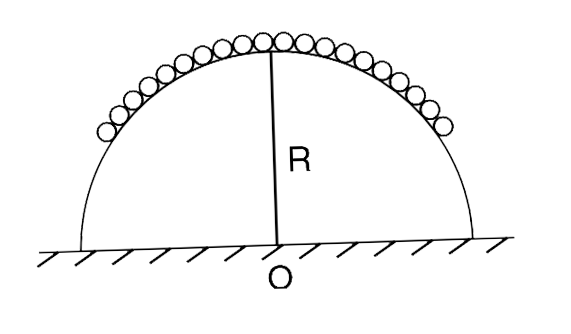
(c) In part (b) assume that the half cylinder is not fixed and can slide on the smooth floor. Find the displacement of the cylinder by the time one end of the chain touches the floor. Mass of cylinder is equal to that of the chain. For part (b) and (c) assume that the chain remains in contact with the cylinder all the while. View SolutionQuestion 98
A small body of mass m is at rest inside a narrow groove carved in a disc. Groove is a circle of radius R concentric to the disc. Mass of the disc is also m . The disc lies on a smooth horizontal floor. The small body is given a sharp impulse so that it acquires a tangential velocity Vo at time t = 0.
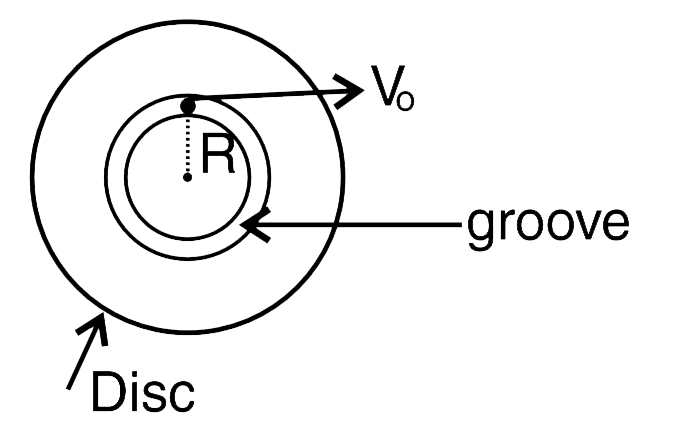
(a) The velocity of the centre of the disc becomes zero for the first time at time t0. Find t0
(b) Find speed of the small body at time t03 View SolutionQuestion 99
Laila and Majnu are on a boat for a picnic. The boat is initially at rest. Laila has a big watermelon which she throws towards Majnu. The man catches the melon and eats half of it. He throws back the remaining half to Laila. She eats the half of the melon that she receives & throws the remaining part to Majnu. Majnu again eats half of what he receives and returns the remaining part back to Laila. This continues till the melon lasts. The two are sitting at the two ends of the boat which has a length L. Combined mass of the boat and the two lovers is M0 and the mass of the water melon is M. Assume that the boat can move horizontally on water without any resistive force. Find the displacement of the boat when the watermelon gets finished.
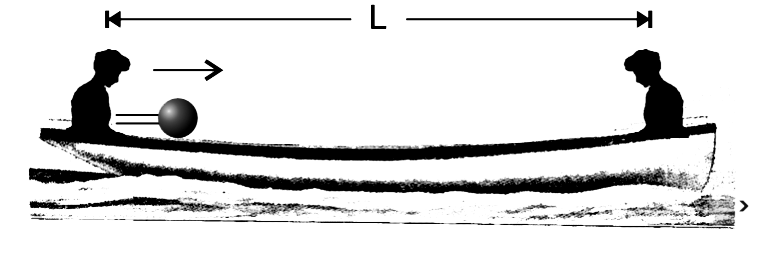 View Solution
View SolutionQuestion 100
A hot air balloon (mass M) has a passenger (mass m) and is stationary in the mid air. The passenger climbs out and slides down a rope with constant velocity u relative to the balloon.
(a) Show that when the passenger is sliding down, there is no change in mechanical energy (kinetic + gravitational potential energy) of the system (Balloon + passenger). Calculate the speed of balloon.
(b) Calculate the power of the buoyancy force on the system when the man is sliding. For easy calculation, assume that volume of man is negligible compared to the balloon.
(c) If buoyancy force is doing positive work, where is this work done lost? You have proved that sum of kinetic and potential energy of the system remains constant
 View Solution
View SolutionQuestion 101
A wooden wedge of mass 10m has a smooth groove on its inclined surface. The groove is in shape of quarter of a circle of radius R=0.55m. The inclined face makes an angle θ=cos−1(√115) with the horizontal A block 'A' of mass m is palced at the top of the groove and given a gentle push so as to slide along the groove. There is no friction between the wedge and the horizontal ground on which it has been placed. Neglect width of the groove.
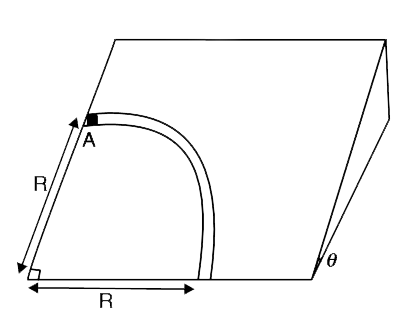
(a) Find the magnitude of displacement of the wedge by the instant the block A reaches the bottom of the groove
(b) Find the velocity of a wedge at the instant the block A reaches the bottom of the groove.View SolutionQuestion 102
A uniform bar AB of length 6a has been placed on a horizontal smooth table of width 5 a as shown in the figure. Length 2a of the bar is overhanging. Mass of the bar is 4m. An insect of mass m is sitting at the end A of the bar. The insect walks along the length of the bar to reach its other end B.
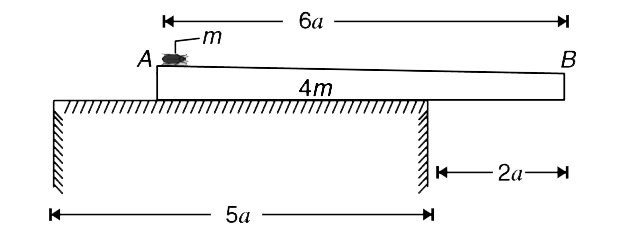
(a) Will the bar topple when the insect reaches end B of the bar ?
(b) After the insect reaches at B, another insect of mass M lands on the end A of the bar. Find the largest value of M which will not topple the bar. View SolutionQuestion 103
A disc of mass M and radius R lies on a smooth horizontal table. Two men, each of mass M2, are standing on the edges of two perpendicular radii at A and B
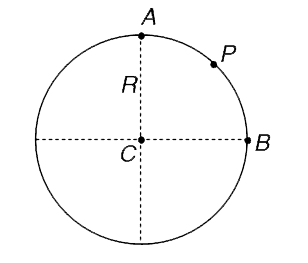
Find the displacement of the centre of the disc if
(a) The two men walk radically relative to the disc so as to meet at the centre C
(b) The two men walk along the circumference to meet at the midpoint (P) of the are AB.View SolutionQuestion 104
There particles A, B and C have masses m, 2m and m respectively. They lie on a smooth horizontal table connected by light inextensible strings AB and BC. The string are taut and <ABC=120∘. An impulse is applied to particle A along BA so that it acquires a velocity u. Find the initial speeds of B and C.
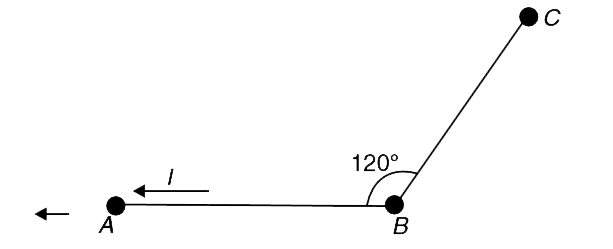 View Solution
View SolutionQuestion 105
A smooth hollow U shaped tube of mass 2m is lying at rest on a smooth horizontal table. Two small balls of mass m, moving with velocity u enter the tube simultaneously in symmetrical fashion. Assume all collisions to be elastic. Find the final velocity of the balls and the tube.
 View Solution
View SolutionQuestion 106
There are 40 identical balls travelling along a straight line on a smooth horizontal table. All balls have equal speed v and each one is travelling to right or left. All collisions between the balls is head on elastic. At some point in time all balls will have fallen off the table. The time at which this happens will definitely depend on initial positions of the balls. Over all possible initial positions of the balls, what is the longest amount of time that you would need to wait to ensure that the table has no more balls? Assume that length of the table is L.
 View Solution
View SolutionQuestion 107
A small ball of mass m is suspended from the end A of a L shaped mass less rigid frame which is fixed to a block of mass m. The block is placed on a smooth table. The ball is given a horizontal impulse so as to impart it a velocity of u. The ball beings to rotate in a circle of radius R about the point A, while the block and the frame slide on the table. Find the tension in the string, to which the ball is attached, at the instant the ball is at the top most position. The rod does not interfere with the string during the motion.
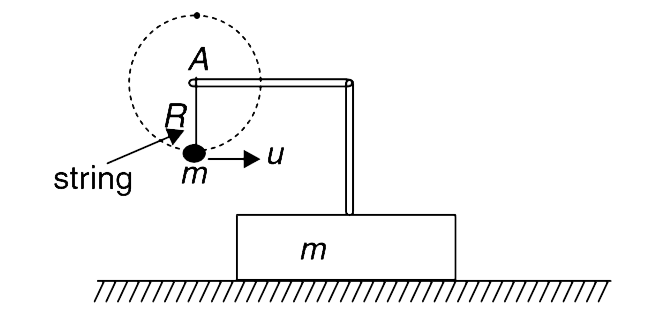 View Solution
View SolutionQuestion 108
A heavy rope of mass m and length 2L is hanged on a smooth little peg with equal lengths on two sides of the peg. Right part of the rope is pulled a little longer and released. The rope begins to slide under the action of gravity. There is a smooth cover on the peg (so that the rope passes through the narrow channel formed between the peg and the cover) to prevent the rope from whiplashing.
(a) Calculate the speed of the rope as a function of its length (x) on the right side.
(b) Differentiate the expression obtained in (a) to find the acceleration of the rope as a function of x.
(c) Write the rate of change of momentum of the rope as a function of x. Take downward direction as positive
(d) Find the force applied by the rope on the peg as a function of x.
(e) For what value of x, the force found in (d) becomes zero? What will happen if there is no cover around the peg ?
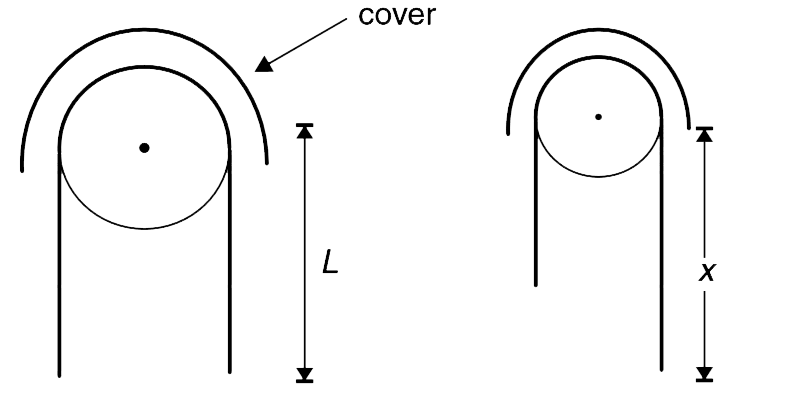 View Solution
View SolutionQuestion 109
Two thin rings of slightly different radii are joined together to make a wheel (see figure) of radius R. There is a very small smooth gap between the two ring. The wheel has a mass M and its centre of mass is at its geometrical centre. The wheel stands on a smooth surface and a small particle of mass m lies at the top (A) in the gap between the rings. The system is released and the particle begins to slide down along the gap. Assume that the ring does not lose contact with the surface.
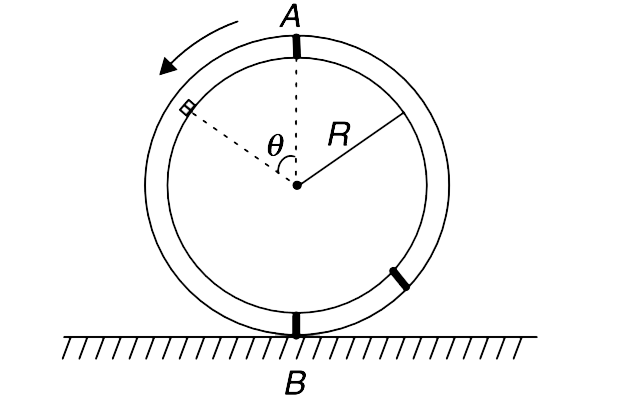
(a) As the particle slides down from top point A to the bottom point B, in which direction does the centre of the wheel move?
(b) Find the speed of centre of the wheel when the particle just reaches the bottom point B. How much force the particle is exerting on the wheel at this instant?
(c) Find the speed of the centre of the wheel at the moment the position vector of the particle with respect to the centre of the wheel makes an angle q with the vertical. Do this calculation assuming that the particle is in contact with the inner ring at desired value of θView SolutionQuestion 110
A large number of small identical blocks, each of mass m, are placed on a smooth horizontal surface with distance between two successive blocks being d. A constant force F is applied on the first block as shown in the figure

(a) If the collisions are elastic, plot the variation of speed of block 1 with time.
(b) Assuming the collisions to be perfectly inelastic, find the speed of the moving blocks after n collisions. To what value does this speed tend to if n is very large.View SolutionQuestion 111
Two small balls, each of mass m are placed on a smooth table, connected with a light string of length 2l, as shown in the figure. The midpoint of the string is pulled along y direction by applying a constant force F. Find the relative speed of the two particles when they are about to collide. If the two masses collide and stick to each other, how much kinetic energy is lost.
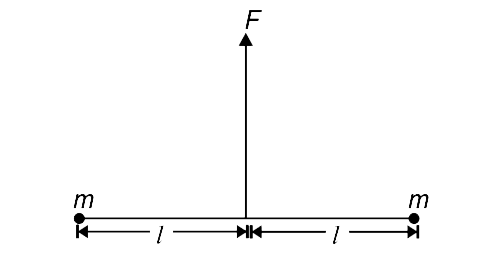 View Solution
View SolutionQuestion 112
A block of mass M is tied to a spring of force constant K and the system is suspended vertically. Consider three situations shown in fig. (a), (b) and (c).
(a) In fig. (a), an insect of mass M is clinging to the block and the system is in equilibrium. The insect leaves the block and falls. Find the amplitude of resulting oscillations.
(b) In fig. (b), an insect of mass M is resting on the top of the block and the system is in equilibrium. The insect suddenly jumps up with a speed u=g√MK and the block starts oscillating. Find amplitude of oscillation assuming that the insect never falls back on the block
(c) In fig. (c), an insect of mass M falls on the block this in equilibrium. The insect hits the block with velocity u=g√MK while moving downwards sticks to the block. Find the amplitude of oscillation.
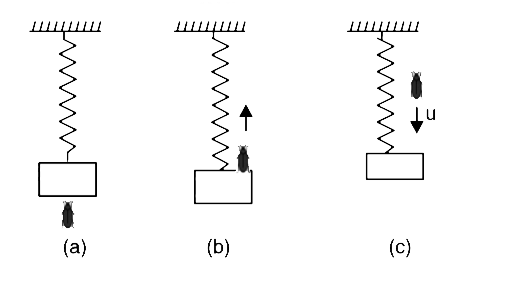 View Solution
View SolutionQuestion 113
A massive ball (A) is dropped from height h on a smooth horizontal floor. A smaller ball (B) is also dropped simultaneously. Initially ball B was just touching ball A (see fig.). Radii of both balls is much smaller than h. Ball A hits the floor, rebounds and immediately hits B. Motion of both the balls is vertical before the collision of two balls. All collision are elastic and there is no friction. Ball B lands at point P on the ground after colliding with A. Find OP, assuming that it is large compared to radius of A.
 View Solution
View SolutionQuestion 114
Disc A of radius R is lying flat on a horizontal surface. Disc B is also at rest. Disc C, which is identical to B is traveling along the surface with its velocity parallel to the line joining the centre C1andC2 of the discs A and B. The distance between the line C1C2 and the line of motion of centre of disc C is √3r , where r is radius of both B and C. Impact of C with B is completely elastic. Subsequently it is observed that both B and C just miss hitting the disc A. Find the radius (R) of A in terms of r.
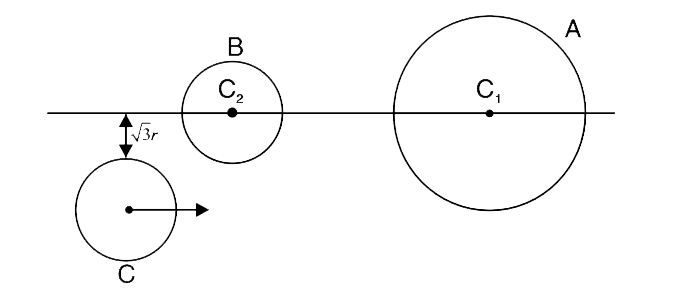 View Solution
View Solution
